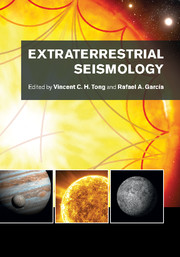Book contents
- Frontmatter
- Contents
- List of contributors
- Preface
- Acknowledgements
- List of abbreviations
- Planetary seismology: High risk, high return
- A bright outlook for helio- and asteroseismology
- Part I Observation and space missions
- Part II Data and physical parameters
- Part III Modeling approaches
- Part IV Discoveries of physical structures and processes
- Part V Interdisciplinary research involving planetary and astrophysical sciences
- 16 Diskoseismology of accretion disks
- 17 Numerical simulations of magnetoconvection and helioseismology
- 18 Impact seismology on terrestrial and giant planets
- 19 Angular momentum transport in stars: From short to long time scales
- 20 From the Sun to the distant stars, and back: Future research directions
- 21 Stellar dynamics: Rotation, convection, and magnetic fields
- 22 Sunquakes: Helioseismic response to solar flares
- 23 Seismic waves in small bodies: Sources and propagation
- Part VI Interdisciplinary research involving terrestrial seismology
- References
- Index
22 - Sunquakes: Helioseismic response to solar flares
from Part V - Interdisciplinary research involving planetary and astrophysical sciences
Published online by Cambridge University Press: 05 July 2015
- Frontmatter
- Contents
- List of contributors
- Preface
- Acknowledgements
- List of abbreviations
- Planetary seismology: High risk, high return
- A bright outlook for helio- and asteroseismology
- Part I Observation and space missions
- Part II Data and physical parameters
- Part III Modeling approaches
- Part IV Discoveries of physical structures and processes
- Part V Interdisciplinary research involving planetary and astrophysical sciences
- 16 Diskoseismology of accretion disks
- 17 Numerical simulations of magnetoconvection and helioseismology
- 18 Impact seismology on terrestrial and giant planets
- 19 Angular momentum transport in stars: From short to long time scales
- 20 From the Sun to the distant stars, and back: Future research directions
- 21 Stellar dynamics: Rotation, convection, and magnetic fields
- 22 Sunquakes: Helioseismic response to solar flares
- 23 Seismic waves in small bodies: Sources and propagation
- Part VI Interdisciplinary research involving terrestrial seismology
- References
- Index
Summary
Introduction and overview
Sunquakes observed in the form of expanding wave ripples on the surface of the Sun during solar flares represent packets of acoustic waves excited by flare impacts and traveling through the solar interior. The excitation impacts strongly correlate with the impulsive flare phase, and are caused by the energy and momentum transported from the energy release sites. The flare energy is released in the form of energetic particles, waves, mass motions, and radiation. However, the exact mechanism of the localized hydrodynamic impacts that generate sunquakes is unknown. Solving the problem of the sunquake mechanism will substantially improve our understanding of the flare physics. In addition, sunquakes offer a unique opportunity for studying the interaction of acoustic waves with magnetic fields and flows in flaring active regions, and for developing new approaches to helioseismic acoustic tomography.
Solar flares represent a process of rapid transformation of the magnetic energy of active regions into the kinetic energy of charged particles, plasma flows, and heating of the solar atmosphere and corona. The primary energy release during the flares is believed to occur in the corona as a result of magnetic reconnection. It is generally believed that most of the energy released by the reconnection goes directly and indirectly (via plasma waves) to acceleration of electrons and protons which are injected into flaring magnetic loops (Figure 22.1a). Most of the observed radiation is produced either directly by these particles or indirectly through energization of the background plasma.
It was suggested long ago (Wolff, 1972) that flares may cause acoustic waves traveling through the solar interior, similar to the seismic waves in the Earth. Because the sound speed increases with depth, the waves are refracted in the deep layers of the Sun (Figure 22.1b), and then appear on the surface, forming expanding rings, similar to ripples on a water surface.
- Type
- Chapter
- Information
- Extraterrestrial Seismology , pp. 306 - 322Publisher: Cambridge University PressPrint publication year: 2015
- 6
- Cited by



